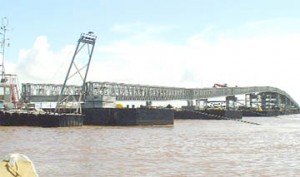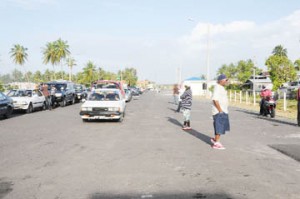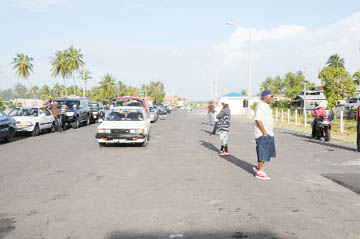More than 35,000 vehicles have crossed the Berbice River Bridge since its opening three months ago with an increase following the reduction of toll charges from March 1 on certain classes of vehicles.
Chief Executive Officer (CEO) of the Berbice Bridge Company Incorporated, Omadatt Samaroo told this newspaper that from Decem-ber 24 last to February 28 the amount of vehicles that crossed the bridge was 20,786.

For the same period, he said, there was a record of 2,732 motorcycles, 2,259 cars, 686 pick-ups, 2,281 FWDs/SUVs while for 15 and 30-seater minibuses the amount that used the bridge was 10,471 and 64 respectively.
He said too that for goods vehicle weighing 1000 kg there were 472 and those between 1001 to 2000 kg and 2001 to 3000 kg totalled 1,287 and 436 respectively.
The CEO also pointed out that for that period the bridge was not accommodating heavy vehicles, however, 15 two and three-axle trucks went across while there was only one “articulated” truck, 28 tractors and 18 one and two-axle trailers.
In the categories of trawler and coastal vessels there were 23 crossings while there were 13 retractions for ocean-going vessels.
Samaroo mentioned that after the reduction of toll charges from March 1 for all classes of vehicles, excepting cars and 15-seater minibuses that have continued to pay the same toll of $2,200 a total of 14,284 vehicles were recorded to have crossed.
Motorcycles have also continued to pay the same toll of $200 and from March 1 to 19 a total of 826 of them have crossed the bridge.
Suzuki Vitara and RAV4s that were paying a toll of $4,000 have now been categorized as cars and are enjoying a toll of $2,200. The total number of cars and pick-ups that have used the bridge has been recorded as 8,204 and 15-seater and 30-seater mini-buses as 3,625 and 34 respectively.
According to Samaroo, five categories of vehicles have been removed; three types of goods vehicle as well as two and three axle trucks.
These have been replaced by three other categories, he said.
Tundras, Pathfinders and Prados, which had been classified as pick-up trucks have now fallen under the SUV category and instead of paying $7,600 and $13,600, depending on the weight, a toll of $4,000 is now being charged.

The amount of those types of vehicles that have used the bridge since the reduction has been recorded as 502, while 754 small trucks have enjoyed the service as well as 267 medium trucks weighing 4001 kg to 8000 kg and 43 large trucks that weigh between 8001 kg and 14,000 kg.
Seven tractors and 19 one and two-axle trailers as well as three articulated trucks have also crossed up to March 19. Up to that period too, the bridge had to be retracted to accommodate 14 trawlers and ocean-going vessels.
Ramp on retractor span
Commuters had complained relentlessly about the steep toll charges to cross the bridge and it was only after the Chambers of Commerce in Berbice arranged a meeting with members of the BBCI that the reduction was considered.
Meanwhile, drivers had told this newspaper that they are happy that the hours of waiting in long lines to cross with the ferry is finally over.
According to them “many times the ferry would break down and leave us stranded or sometimes other drivers used to come from behind and pay to get in the boat before we.”
Though grateful for the bridge, they are concerned about the long wait during retractions to accommodate ocean-going vessels. They said too that at times there would be unscheduled openings which cause them a lot of delays.
Further, they are worried about having to endure the “nightmare” again for at least four days at the end of April or early May when the bridge is expected to be closed.
Samaroo told this newspaper that the closure is necessary to replace the ramp on the retractor span; the components and cylinders for the ramp were expected in the country.
He pointing out that the bridge is still in the one-year defects and liability period and that the “abnormalities” which have been observed on the ramp would have to be rectified before that period is up.
The CEO said there are three or four scheduled openings [of the retractor span] per week but at present there may be unscheduled openings to allow contractors to correct some defects. He is hoping that those repairs would help the expected closure to take less than four days.
Further, he said, each retraction was supposed to last for one and a half hours but it may take an extra hour and a half for routine testing and to ensure the reliability of the mechanism.
He said too that some delays may result from vessels developing mechanical problems while passing.
Samaroo said the bridge, which has modern systems, is the first of its kind in Guyana. It has an electro-mechanical drive system and a state-of-the-art control system with programmable logic controller that allows the retractor span to be aligned.
There are also sensors along the whole bridge, which is controlled electronically and has two motors on either side.
Meanwhile observers have commented that since the opening of the bridge the speeding on the West Berbice road has reduced tremendously. One resident said drivers no longer “have to break necks to catch ferry” or to get to their destinations after crossing.

